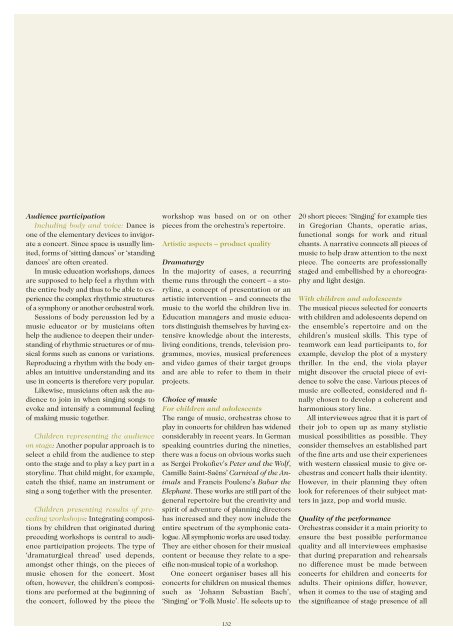exchange die kunst, musik zu vermitteln - Kunstdervermittlung.at
exchange die kunst, musik zu vermitteln - Kunstdervermittlung.at
exchange die kunst, musik zu vermitteln - Kunstdervermittlung.at
Erfolgreiche ePaper selbst erstellen
Machen Sie aus Ihren PDF Publikationen ein blätterbares Flipbook mit unserer einzigartigen Google optimierten e-Paper Software.
Au<strong>die</strong>nce particip<strong>at</strong>ion<br />
Including body and voice: Dance is<br />
one of the elementary devices to invigor<strong>at</strong>e<br />
a concert. Since space is usually limited,<br />
forms of ‘sitting dances’ or ‘standing<br />
dances’ are often cre<strong>at</strong>ed.<br />
In music educ<strong>at</strong>ion workshops, dances<br />
are supposed to help feel a rhythm with<br />
the entire body and thus to be able to experience<br />
the complex rhythmic structures<br />
of a symphony or another orchestral work.<br />
Sessions of body percussion led by a<br />
music educ<strong>at</strong>or or by musicians often<br />
help the au<strong>die</strong>nce to deepen their understanding<br />
of rhythmic structures or of musical<br />
forms such as canons or vari<strong>at</strong>ions.<br />
Reproducing a rhythm with the body enables<br />
an intuitive understanding and its<br />
use in concerts is therefore very popular.<br />
Likewise, musicians often ask the au<strong>die</strong>nce<br />
to join in when singing songs to<br />
evoke and intensify a communal feeling<br />
of making music together.<br />
Children representing the au<strong>die</strong>nce<br />
on stage: Another popular approach is to<br />
select a child from the au<strong>die</strong>nce to step<br />
onto the stage and to play a key part in a<br />
storyline. Th<strong>at</strong> child might, for example,<br />
c<strong>at</strong>ch the thief, name an instrument or<br />
sing a song together with the presenter.<br />
Children presenting results of preceding<br />
workshops: Integr<strong>at</strong>ing compositions<br />
by children th<strong>at</strong> origin<strong>at</strong>ed during<br />
preceding workshops is central to au<strong>die</strong>nce<br />
particip<strong>at</strong>ion projects. The type of<br />
‘dram<strong>at</strong>urgical thread’ used depends,<br />
amongst other things, on the pieces of<br />
music chosen for the concert. Most<br />
often, however, the children’s compositions<br />
are performed <strong>at</strong> the beginning of<br />
the concert, followed by the piece the<br />
workshop was based on or on other<br />
pieces from the orchestra’s repertoire.<br />
Artistic aspects – product quality<br />
Dram<strong>at</strong>urgy<br />
In the majority of cases, a recurring<br />
theme runs through the concert – a storyline,<br />
a concept of present<strong>at</strong>ion or an<br />
artistic intervention – and connects the<br />
music to the world the children live in.<br />
Educ<strong>at</strong>ion managers and music educ<strong>at</strong>ors<br />
distinguish themselves by having extensive<br />
knowledge about the interests,<br />
living conditions, trends, television programmes,<br />
movies, musical preferences<br />
and video games of their target groups<br />
and are able to refer to them in their<br />
projects.<br />
Choice of music<br />
For children and adolescents<br />
The range of music, orchestras chose to<br />
play in concerts for children has widened<br />
considerably in recent years. In German<br />
speaking countries during the nineties,<br />
there was a focus on obvious works such<br />
as Sergei Prokofiev’s Peter and the Wolf,<br />
Camille Saint-Saëns’ Carnival of the Animals<br />
and Francis Poulenc’s Babar the<br />
Elephant. These works are still part of the<br />
general repertoire but the cre<strong>at</strong>ivity and<br />
spirit of adventure of planning directors<br />
has increased and they now include the<br />
entire spectrum of the symphonic c<strong>at</strong>alogue.<br />
All symphonic works are used today.<br />
They are either chosen for their musical<br />
content or because they rel<strong>at</strong>e to a specific<br />
non-musical topic of a workshop.<br />
One concert organiser bases all his<br />
concerts for children on musical themes<br />
such as ‘Johann Sebastian Bach’,<br />
‘Singing’ or ‘Folk Music’. He selects up to<br />
132<br />
20 short pieces: ‘Singing’ for example ties<br />
in Gregorian Chants, oper<strong>at</strong>ic arias,<br />
functional songs for work and ritual<br />
chants. A narr<strong>at</strong>ive connects all pieces of<br />
music to help draw <strong>at</strong>tention to the next<br />
piece. The concerts are professionally<br />
staged and embellished by a choreography<br />
and light design.<br />
With children and adolescents<br />
The musical pieces selected for concerts<br />
with children and adolescents depend on<br />
the ensemble’s repertoire and on the<br />
children’s musical skills. This type of<br />
teamwork can lead participants to, for<br />
example, develop the plot of a mystery<br />
thriller. In the end, the viola player<br />
might discover the crucial piece of evidence<br />
to solve the case. Various pieces of<br />
music are collected, considered and finally<br />
chosen to develop a coherent and<br />
harmonious story line.<br />
All interviewees agree th<strong>at</strong> it is part of<br />
their job to open up as many stylistic<br />
musical possibilities as possible. They<br />
consider themselves an established part<br />
of the fine arts and use their experiences<br />
with western classical music to give orchestras<br />
and concert halls their identity.<br />
However, in their planning they often<br />
look for references of their subject m<strong>at</strong>ters<br />
in jazz, pop and world music.<br />
Quality of the performance<br />
Orchestras consider it a main priority to<br />
ensure the best possible performance<br />
quality and all interviewees emphasise<br />
th<strong>at</strong> during prepar<strong>at</strong>ion and rehearsals<br />
no difference must be made between<br />
concerts for children and concerts for<br />
adults. Their opinions differ, however,<br />
when it comes to the use of staging and<br />
the significance of stage presence of all


